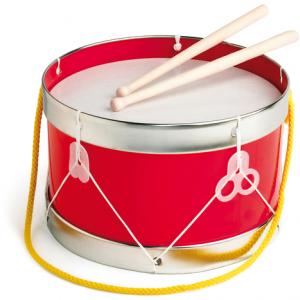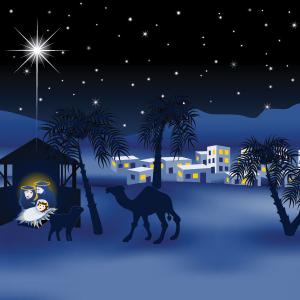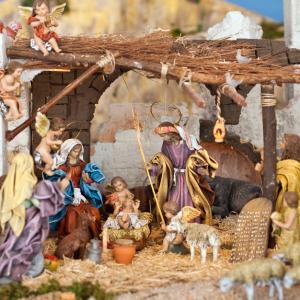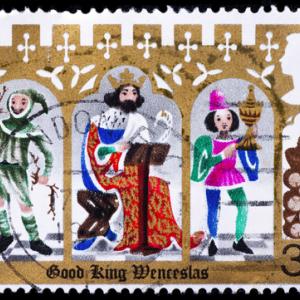Examining the Social Justice Themes in Christmas Carols

Even when we do realize what we’re singing, how often do we actually let those words transform our hearts or actions or perspectives? When we think about the Christmas season, do we think of it as the time to reflect on our Savior coming to earth as an infant — the most peaceful form possible — in order to loose the chains of injustice, untie the cords of every yoke, and to set the oppressed free? Or do we allow ourselves to be swept away in the current of our culture, consuming products laboriously and painfully produced by the very people God created for Jesus to save, and whom we are called to protect and love in his name?
Scroll through these reflections on our beloved Christmas hymns for a deeper take.

“The Little Drummer Boy” tells a wonderful short story of a poor boy who feels he has no gift to give to the baby Jesus. In spite of his lack of gifts, he offers to play his drum for him, to the delight of all in the stable, especially baby Jesus, who smiles at the drummer boy.
Not only is this song fun to sing with its drum-like “pa-rum-pum-pum-pums,” but also it embraces a non-materialistic message that we all need to hear, especially this time of year. In a society of hyper-commercialized Christmas, where we are bombarded with advertisements filled with the pressure to find the perfect gift, “The Little Drummer Boy” challenges this societal expectation. Perhaps the perfect gift is really just ourselves, being who we are, bringing our own gifts and talents to each other and to a world in deep need of healing.
While the boy is poor and feels like he has nothing to offer, he has a drum and plays for those gathered at the stable — and they are pleased. While our society pressures us to perform, to prove our love and appreciation for someone, it is actually the simple sharing of life, being together with family and friends around good food and drink — and maybe even dance and sing (with a drum!) — that is what we truly need or want around Christmas time. I know this is true for me.

One carol I’ve been humming this Advent is “I Saw Three Ships Come Sailing In.” It’s not one I grew up singing, but I love it. The most popular contemporary lyrics talk about “three ships come sailing in” to Bethlehem on Christmas morning. Bruce Cockburn says the weird lyrics are the result of English folk in the 18th century hallucinating from eating too much ergot in their moldy English bread. Certainly there were no ships sailing into landlocked Bethlehem.

“What Child is This,” written by William C. Dix in 1865 is one of the few Christmas carols I know of that does not have its own musical arrangement. It uses the tune, “Greensleeves” (a traditional English folk song, thought to have been written in the late 16th or early 17th century), which when paired with Dix’s lyrics creates a haunting and beautiful image of the birth of our Lord.
There’s another song that’s less well-known titled “Child of the Poor,” written by Scott Soper (published in 1994). The counter melody blends stunningly with the melody of “What Child is This.” Reading the lyrics, side by side, gives me chills. In part, because it reminds me that hope is found in low places — God could’ve chosen to be raised in comfort (as Moses was). The cross was only the finale of Jesus’ discomfort. “Child of the Poor” honors the death and discomfort we often don’t want to think about while we’re sitting around the fire drinking cocoa.

Whoops. I was joking with a co-worker today about writing a subversive post about how the song “Do You Hear What I Hear” is an extended metaphor for the Roman Empire’s takeover of Christianity, contorting Jesus’ message for its own ends. “Listen to what I say,” orders the unnamed king, as he urges adoration of Jesus and calls for peace — Pax Romana.
I did a quick Wikipedia search, and learned exactly how wrong I was. Rather than a subversive message about the twisting of the Gospel, “Do You Hear What I Hear” was actually a call for peace during the turbulence of the 1960s.
I mean, think about it: the song talks about the humbleness of the announcement of Jesus’ birth – only the night wind and the little lamb have heard about it. This whisper gets passed up to ever-increasing degrees of authority (a grassroots movement if we’ve ever seen one), until the king himself is calling for peace.

I don’t know about you, but I’m pretty sure I have sung “O Little Town of Bethlehem” every year on Christmas Eve for my entire life. But I believe this carol’s lyrics, specifically the words of the first verse, invite a little more thought than we normally give them.
O little town of Bethlehem
How still we see thee lie
Above thy deep and dreamless sleep
The silent stars go by
Yet in thy dark streets shineth
The everlasting light
The hopes and fears of all the years
Are met in Thee tonight
For now let’s ignore the historical inaccuracies of the song, and focus on what the words mean, especially the last four lines. How beautiful is it that through the dark world a light came to bind together the hopes and fears of all the years (I choose to see it as past and future) in Jesus?

I’m sure most of us have played the scene in our heads one too many times: little baby Jesus, presumably Caucasian, lying in a tiny crib-esque manger comfortably padded with hay — even though the song specifically says “no crib for a bed” — while the animals, which are perfectly behaved, quietly and reverently look on. Cue the wise men, in their strange, exotic garb, and sprinkle a few angels in there — you know, the ones that look like babies with wings and white togas.
That was my impression of the nativity scene as a kid, and the popular children’s Christmas carol, “Away in a Manger” didn’t do anything to help. It seemed to perpetuate the picturesque nativity image of most of the figurine depictions in our living rooms.
But, if only for a few minutes, put aside the notions that the “manger” probably wasn’t as clean and cozy as we thought, that it probably wasn’t a silent night — have you met a baby that’s gone through its first 24 hours without crying? — or that Jesus probably wasn’t snug in a crib conveniently left in a manger.
Even though the song may seem like it only deserves a cursory glance, as it was originally published in theLittle Children's Book for Schools and Families in 1885, I purport there’s something more to the childhood classic.

When I go home for Christmas, I always end up pulling out the old Christmas songbook from inside the piano bench and working my way through while my mom cooks dinner. I don’t really read the music as much as I read the chords and play by ear. Good King Wenceslas is a beautiful song musically, but is one of the most fun songs to play because of the never-ending chord changes.
I never really considered what the song was about, being raised in a school system that taught of the tyranny of monarchies and the Revolutionary War. Medieval leaders ruled in an age of knights, castles, and oppressed peasants. But then there was Wenceslas (who I now know was the Duke of Bohemia).

I’ve been really lucky this month to hear some of my co-workers’ reflections on the social justice implications of their favorite Christmas carols. It’s been a great opportunity to reflect back on what it is we sing and celebrate each year, the truths we profess without even knowing it.
Naturally, I wanted to get involved, as well. As I was running through the songs I love, "Joy to the World" suddenly popped up in a new light:
Joy to the World, the Lord is come!
Let Earth receive her King;
Let every heart prepare Him room,
And Heaven and nature sing,
And Heaven and nature sing,
And Heaven, and Heaven, and nature sing.

I can remember hearing several times as a middle and high schooler that Christians lie the most when they sing. These claims generally came from the mouths of college-aged worship leaders during emotional praise segments at mission camps and conferences. They were usually followed up with a heartfelt plea to raise honest words and promises to God during the next song. (And if we really meant it, we would ignore the burning stares of our judgmental, worldly peers and come down front for our seventh altar call.)
Though I generally don’t remember these scenes and indictments fondly, I have recently been contemplating the idea of honest worship, especially in relation to the Christmas season. I mean, how often do we memorize a whole song and sing along to it regularly without really stopping to contemplate the lyrics? And even when we do realize what we’re singing, how often do we actually let those words transform our hearts or actions or perspectives?
All of these thoughts started stewing in my mind during my Thanksgiving vacation two weeks ago. Per usual, I started playing Christmas music the day after Thanksgiving (and by the day after I mean a few days before). As I was washing dishes, belting out my favorite version of “O! Holy Night,” I was suddenly struck with the thought What am I singing? Read the lyrics below to see if you get what I mean. (Hint: my moment happened somewhere around the second verse.)